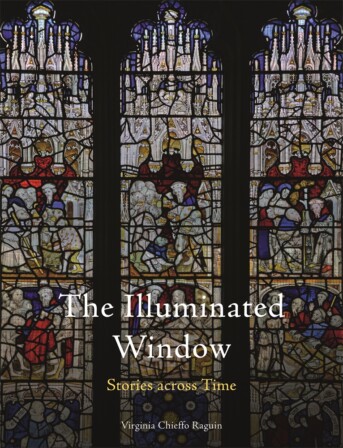
By Virginia Chieffo Raguin
Reaktion Books – £30.00
Then he went up from there to Bethel, and as he was going up the road, some youths came from the city and mocked him, and said to him, ‘Go up, you baldhead! Go up, you baldhead!’ So he turned around and looked at them, and pronounced a curse on them in the name of the Lord. And two female bears came out of the woods and mauled 42 of the youths (2 Kings 2:23-5).
(Renaissance Donors In Switzerland).
The element of pattern is made more cheaply and beautifully effective when introduced into the glass of the windows than in the use of any other medium that architecture has to offer. The metal divisions become a metal screen of any pattern – heavy or light, played in any metal, even gold or silver – the glass a subordinate, rhythmical accent of any emotional significance whatever, or vice versa. The pattern may be calculated with reference to the scale of the interior and the scheme of decoration given by, or kept by, the motif of the glass pattern.
(The Light Screens of Frank Lloyd Wright).
Informed, inspired and highly imaginative, The Illuminated Window – Stories across Time, is as its author Virginia Chieffo Raguin herself states, the sort of book that can be picked up at any time and in any order, purely as a result of its well-versed the subject matter surpassing any any remote form of chronology: ‘’It is hoped that this series of studies encourage the reader to peruse the text in any order, starting with what first engages attention, as something new, or something familiar. References to other chapters and their concepts are interspersed through the text, encouraging the reader to review, compare and contemplate.’’
Key amid the immediate above is the final word ‘contemplate,’ wherein the reader – whether informed or not – is indeed invited to both ‘review’ and ‘compare’ the many varying aspects of this book’s twelve chapters.
Be it the grand, albeit spurious religiosity of the first of the opening two quotations taken from the seventh chapter ‘Renaissance Donors In Switzerland,’ which Raguin precedes in relation to Elisha Taunted by Boys (1657) with: ‘’The unusual central image is inscribed: Eliseus der from Gotts man/ward mit schmach worten grifen an/von bösen vngezognen Knaben drum Zwen ber[en] sy Zerisen haben (Elisha, who was from God, was attacked with abusive words; by bad naughty boys, thus they were torn [mauled] by two bears). This incident in the life of the prophet Elisha is found in the Bible.’’
Admittedly a tad violent; although said violence is invariably reflected throughout the bible, which in turn, is invariably brought to bear amid many a stained-glass window amid many of the world’s finest churches and cathedrals. One such perfect example mentioned herein is the Trinity Chapel of Canterbury Cathedral, where on page 36, a knight, Eilward of Westoning, is (in full glorious colour) shown to be horribly blinded and castrated.
Moreover, there is far more to this wonderfully presented book than the mere depiction of religiously induced violence.
The penultimate chapter traverses the work of the afore-quoted distinguished American architect, Frank Lloyd Wright, who ‘’concerned that the window be seen as a window, as well as an object of unusually attractive decorative materials,’’ reminds us that:
‘’nothing is more annoying to me than any tendency toward realism of form in window glass, to get mixed up with the view outside. A window pattern should stay severely ‘put’… The magnificent window-painting and plating [a reference to opalescent techniques] of the windows of the religious edifice is quite another matter. There the window becomes primarily a gorgeous painting – painting with light itself.’’
As Dell Upton, Emeritus Professor of Art History at the University of California in Los Angeles has since written: ‘’The Illuminated Window is a delight for the eye and the mind. Through gorgeous colour photographs and vivid analysis, Virginia Chieffo Raguin demonstrates the importance of stained glass as art, as narrative, and as a feature of ambitious sacred and secular buildings from the Middle Ages to the present.’’
Beautiful presented and written with both chutzpah and panache, this book surely sets the bar in relation to is subject matter.
David Marx
